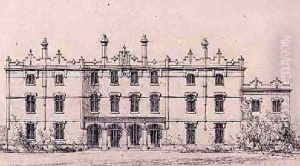Edward Buckton Lamb Paintings
Edward Buckton Lamb was an English architect, born in 1806, notable for his distinctive and often eccentric architectural designs that were predominantly executed in the Gothic Revival style, yet with an idiosyncratic and often controversial flair that set them apart from the works of his contemporaries.
Lamb was born into a prosperous family and was initially educated at home before being articled to a solicitor. However, he did not proceed with a career in law, choosing instead to pursue his passion for architecture. He was largely self-taught in this field, which perhaps contributed to his unique approach to design. In the 1830s, he began his professional career as an architect and soon garnered attention for his work.
Throughout his career, Lamb's designs were often met with mixed reactions from both the public and his peers. While some appreciated his originality and the individual character of his buildings, others criticized them for their lack of adherence to the period's architectural norms and for their occasional structural impracticalities. Nonetheless, Lamb developed a modest but dedicated clientele who appreciated his style and commissioned both public and private works from him.
Among his most notable works is the church of St Martin, Scarborough, North Yorkshire, which is often cited as an example of his unconventional approach. Lamb's work on the church, completed in 1848, includes a distinctive tower and spire, which stand out for their unusual design and decoration. He also designed a number of parsonages, schools, and private houses, many of which still stand today and serve as testimony to his architectural vision.
Lamb was also an advocate for architectural reform and was known for his strong opinions on the subject. He wrote articles and gave lectures criticizing the architectural establishment of his time, arguing for more freedom and creativity in design. This advocacy did little to endear him to the mainstream architectural community, but it did establish him as a distinctive voice within the profession.
Edward Buckton Lamb died in 1869, leaving behind a legacy of idiosyncratic buildings that continue to be studied and admired for their originality and individualism within the context of Victorian architecture.
